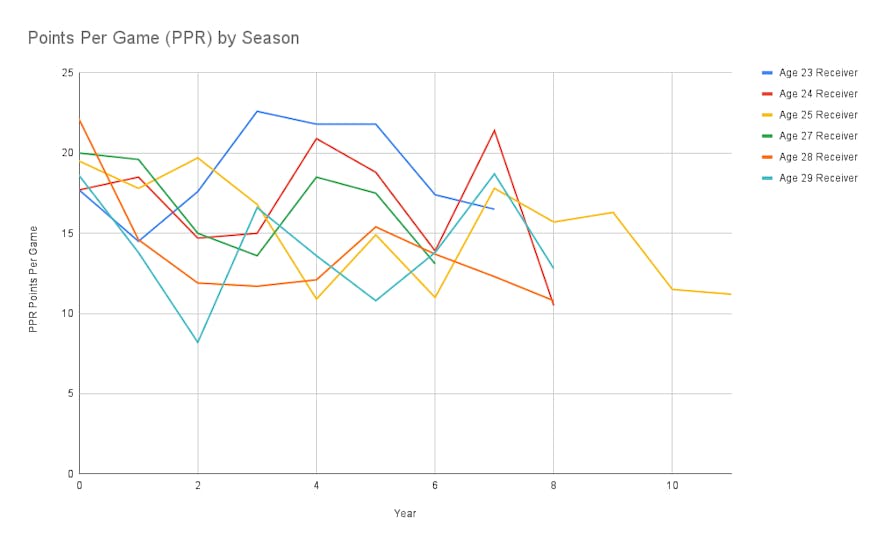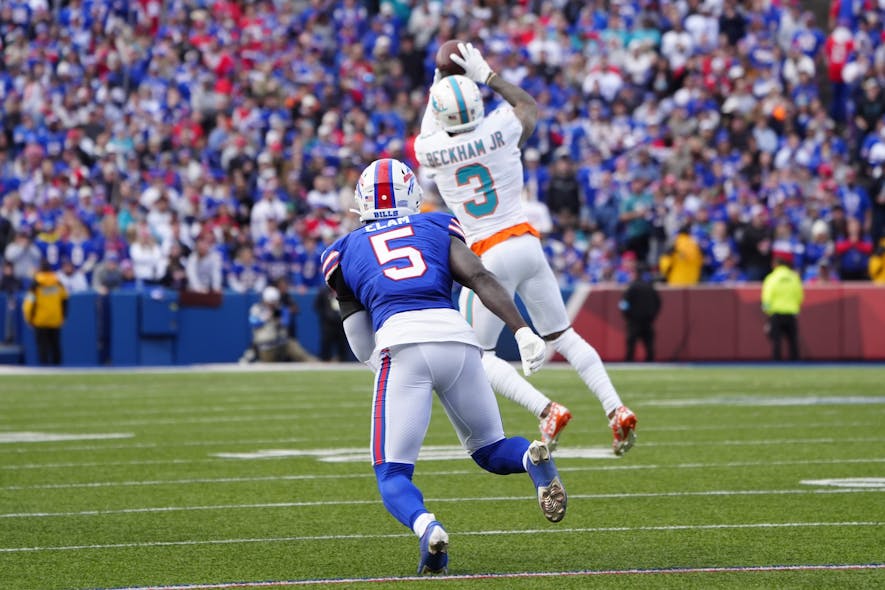There's a lot of strong dynasty analysis out there, especially when compared to five or ten years ago. But most of it is so dang practical-- Player X is undervalued, Player Y's workload is troubling, the market at this position is irrational, and take this specific action to win your league. Dynasty, in Theory is meant as a corrective, offering insights and takeaways into the strategic and structural nature of the game that might not lead to an immediate benefit but which should help us become better players over time.
We're (Still) Probably Thinking About Age the Wrong Way
I often say that thought experiments are my favorite type of experiment because they have all the trappings of science with none of that annoying, labor-intensive "data-gathering and testing" nonsense. To that end, I would like to propose a hypothetical. Imagine it is the end of the season and the top six fantasy receivers are as follows:
- A 23-year-old former high draft pick who had his breakout campaign.
- A 24-year-old former mid-round draft pick who had his second straight top season
- A 25-year-old former high draft pick posting his third top year.
- A 27-year-old former high draft pick with four big years.
- A 28-year-old who posted his fifth top season.
- A 29-year-old who likewise has five top seasons.
How many starter-caliber seasons do you think each receiver would have going forward? (For our purposes, we'll define "starter-caliber" as "over 11 points per game", which is usually around WR36 for the season. This year, receivers in the 11-12 point range include Tyreek Hill, Wan'Dale Robinson, Marvin Harrison Jr.., Courtland Sutton, DJ Moore, George Pickens, Quentin Johnston, etc.)
Take a minute to think about it if you would like.
Let's say that when I simulated possible career paths and selected one at random for each receiver, and upon doing so, found that five of the six receivers had either 6 or 7 seasons left as a fantasy starter. (The sixth had ten seasons left.)
- The 23-year-old had 7 startable seasons left
- The 24-year-old had 7 startable seasons left
- The 25-year-old had 10 startable seasons left
- The 27-year-old had 6 startable seasons left
- The 28-year-old had 7 startable seasons left
- The 29-year-old had 6 startable seasons left

Would you find this outcome implausible? Would you consider it bizarre that the three older receivers essentially lasted as long as the three younger receivers? Would you question how well-calibrated my simulation was?
I hope not, because the "hypothetical season" was 2008, the "hypothetical receivers" were Calvin Johnson, Brandon Marshall, Larry Fitzgerald, Andre Johnson, Anquan Boldin, and Steve Smith, and those are their actual remaining career point per game averages in the graph above.
Let's Talk About Age Curves
The most common way to think about longevity in dynasty is through something called an age curve. You've likely seen one at some point-- they typically show average production by age, with performance starting low, improving over the first few years of a player's career, reaching a peak in the mid-to-late 20s, and then entering a steady decline. Here's a classic example from Chase Stuart of Football Perspective.
There are lots of ways to produce the quintessential curve. The most common is to average production of all players at each age. Another approach is to define a player's best year as his peak, express every age as a percentage of that peak, and average those percentages. (So if a running back's best year is 200 points at Age 24, and that back scores 190 at Age 25, his production for Age 25 is 95% of his peak.)
I've also seen analysts calculate the improvement or decline from year to year and average those to find that, say, running backs typically improve by 10% between age 22 and 23, but decline by 15% between age 27 and 28. Alternately, if you chart every, say, 250-point season in history by age, you once again wind up in the same place.
Each of these approaches produces a curve-- but more than that, each of these approaches produces a largely identical curve. This convergence can't be a coincidence; it's no wonder age curves have become the dominant mode for thinking about aging in fantasy football.
Except there are a lot of problems with age curves, which is why I wrote in 2015 that we were probably thinking about age the wrong way.
Continue reading this content with a ELITE subscription.
An ELITE subscription is required to access content for Dynasty leagues. If this league is not a Dynasty league, you can edit your leagues here.

